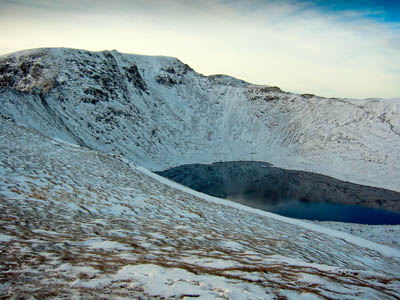
Helvellyn and Red Tarn: rescue would take at least an hour
A national park authority has warned walkers not to venture on to frozen lakes and tarns, as a slow thaw has made many of them dangerous to walk on.
As temperatures slowly rise, the ice on the Lake District’s frozen waters has begun to thin, even on those on the high fells. The problem is particularly acute on the high tarns, where help would take much longer to reach if someone fell into the freezing water.
The Lake District national park’s head of countryside services Mark Eccles said: “We’ve seen people walking, sledging and skating on our frozen waters, but now it’s getting warmer, the dangers are even more acute.
“We know people have been on the ice at Bassenthwaite, Ullswater and Derwent Water over the weekend. Police have asked us to do what we can to highlight the potential danger.
“Lakes and tarns, particularly those at higher levels, could appear to have solid ice, even when it’s thawing, and might not hold a person’s weight.
“Although there have been fatalities in other areas, we haven’t had any serious incidents and want people, and their pets, to keep out of harm’s way. There are still lots of fantastic things to enjoy in the countryside, without going on hazardous, ice-covered water.
“We certainly don’t want to be killjoys. And we don’t want to clutter the countryside with ‘ice danger’ posters.
“With a bit of common sense, this amazing winter landscape can be enjoyed by all those prepared to go the extra distance in keeping themselves protected and safe.”
Mr Eccles warned of the risk of letting dogs go on to the ice. He said: “They could be seriously injured or die, if the ice breaks. And anyone trying to rescue them puts their own life in peril.”
Felltop assessor Jon Bennett said ice on Red Tarn, below the summit of Helvellyn – the Lake District’s third highest peak – was not thick and walkers should not be tempted on it.
“We’ve had instances in the past where people have been playing around on the ice. It’s dangerous beyond words. This is one of the national park’s highest stretches of water.
“People are just not thinking about the consequences of ice breaking. At best, it would take mountain rescue at least an hour to reach them. No one could hold their breath or stay warm for that long.”
Lakeland fell conditions can be accessed via the authority’s Weatherline website. Full forecasts, including the specialist Mountain Weather Information Service reports, can be accessed via grough’s links page.